Head Lice Treatment Series Part 4
Head Lice Information - Know Thy Enemy So You Can Destroy Him
Here is some basic head lice information, so you can know about what you are up against when learning how to treat head lice.
Although I have a B.S. in Biology from an actual four year college, the purpose of this page is not to give you a boring biology lecture and write a science book report.
Instead, the purpose of this information is to know enough about head lice to be able to understand why certain actions I will suggest are important to take, why these actions work in getting rid of head lice, and enough about them to help you understand how to keep from passing them on to others.
To a certain degree this head lice information will also help you indetify them, but that is really more the focus of the next two parts of the series, with head lice pictures, and pictures of head lice nits.
Basically, everything I am going to say I learned from reading some head lice books from the library that are designed for kids.
Head Lice Information - Animal Versus Human Lice
There are a lot of different types of lice in the world, all of which to my understanding are parasites.
The important thing to understand about all these different types of lice is that each type is designed and evolved to live off a different type of host. There are some lice which infest birds, dogs, trees (I know this is a plant, but you get my point), etc.
These lice that are found on these other organisms don't want to infest us, because their life cycle is not designed around humans. That is why, for example, you cannot get lice from your dogs or cats. If your pets have lice it is a different species than what would infest you.
Please note I am talking about lice here. You can get, for example, fleas from your pets. There is some differences in biology with these different types of insects.
The Three Types Of Lice That Feed Off Humans
There are three main types of lice which do infect humans -- head lice, body lice and pubic lice. This series is about head lice, also known by their scientific name of
Pediculus humanus capititis.
As you can easily tell from the name these three species of lice, all of whom have evolved to live off a human host, also have evolved even further to live off a certain part of the human body, and the names of each type of lice explain where you can find them.
You will not find head lice in your socks, for example, or biting your leg. They live only in human hair and feed off the blood they suck from your scalp.
Head Lice Suck Blood - So Do They Cause Diseases?
As soon as I found out this piece of head lice information, that they eat human blood, I became very concerned, because it is common for blood eating or sucking vermin to carry disease with them.
For example, everyone knows that mosquitoes, who eat blood, also can carry malaria and pass it to those they bite. This is not an uncommon phenomenon, and is one reason parasites of any type are such a problem in human populations.
Body lice also eat your blood and they do carry certain diseases. For example, body lice can be very common in wars, where soldiers have to be in tight quarters without being able to practice good hygiene because of battles raging around them. Trench sicknes was carried by these little body lice.
However, from what I have read we have dodged a big bullet with head lice, because they are not known to carry any such diseases. This is actually some positive head lice information. Nonetheless, my personal opinion is that I want to take care of any head lice infestations in my home, on my family, as quickly as possible because I just don't want to take any chances with my family's health.
Head Lice Information - Anatomy And Ability To Move Around
Head lice are wingless insects, so they cannot fly. Like all insects they have 6 legs.
There is a common belief that head lice can jump, for example from one person's hair to another person's hair. What I have read is that their legs are adapted to cling to the hair shaft, so they don't fall off and therefore they are incapable of jumping.
Still, the belief is very persistent, and many people have claimed that they have seen these insects jump. Perhaps they were seeing a different type of insect, I don't know. I don't claim to have personally studied this, but just know quite a number of people in the scientific community say they cannot jump.
That doesn't mean they are incapable of moving around though, either way. As you know, head lice can be very infectious, so they obviously have the ability to easily colonize other heads of hair. They do this through crawling short distances.
For example, head to head contact between individuals can spread a lice infection, such as when kids whisper or hug each other. Further, siblings are generally at more risk if they share pillows and bedding because of how lice can move around.
In addition, a louse inside a coat hood that is laid onto another person's coat can crawl onto the other coat and then transfer later into your child's hair. Similarly, when you share hats or hair brushes lice can spread.
The Life Cycle Of Head Lice - Vital Head Lice Information
If you just skim through everything else on this page, please read this head lice information about the life cycle of head lice. This is the nitty gritty of what you need to know so you can fight a head lice infestation at every stage of these cooties life cycles.
Head lice are insects, as stated above. Just like all other insects they therefore have a very defined life cycle. The diagram below, from the Center for Disease Control, shows this life cycle quite clearly.
Basically, head lice lay eggs, called nits, which when they hatch are baby head lice called nymphs.
Just as with all other insects, head lice have an exoskeleton, and they shed this exoskeleton three times during their life cycle from the smallest nymph to the largest, and then to become an adult louse. Once they hatch until they die head lice, as nymphs or adults, feed on human blood.
Then, once they are adults the lice like to find a boyfriend or girlfriend and make new little lice by mating and laying eggs. Ah, the circle of life.
The reason this head lice information is important is because you need to attack the head lice at every life cycle stage to stop their circle of life and stop the infestation.
I will be discussing this more throughout this head lice treatment series, and will discuss the most effective ways to identify and attack them at each life stage so you can win the war against them.
This post is part of my 14 part series on
Head Lice Treatment. Start at the beginning of the series, and read it all if you need instructions on this right now. Don't panic -- learn the facts before you act!
Previous part of the series: Part 3: Head Lice Symptoms - Find Out When You Or Your Child Might Have Head Lice
Next part of series: Part 5: What Does Lice Look Like? - Head Lice Pictures So You Can Know What You Are Even Looking For
In addition, don't forget that you can share your stories and experiences about lice treatment here.
Related Links At Household Management 101
Head Lice Treatment - How To Get Rid Of Head Lice Series
Health And Safety Tips For Your Family
Go From Head Lice Information To Help You Know How To Treat Head Lice To Household Management 101 Home Page




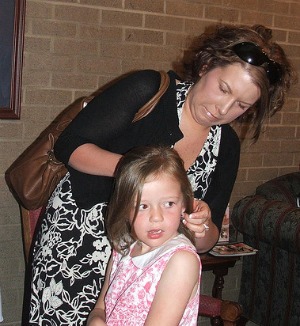
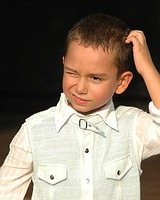
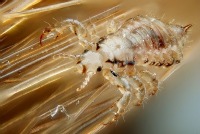
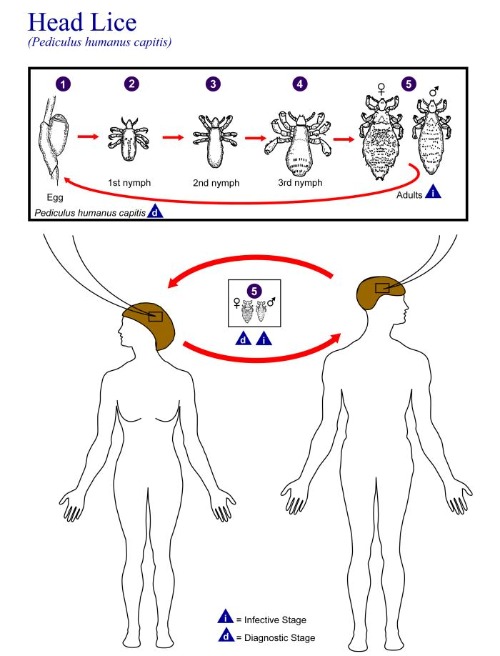
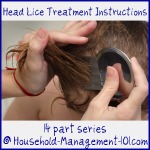
Share Your Comments, Thoughts & Ideas